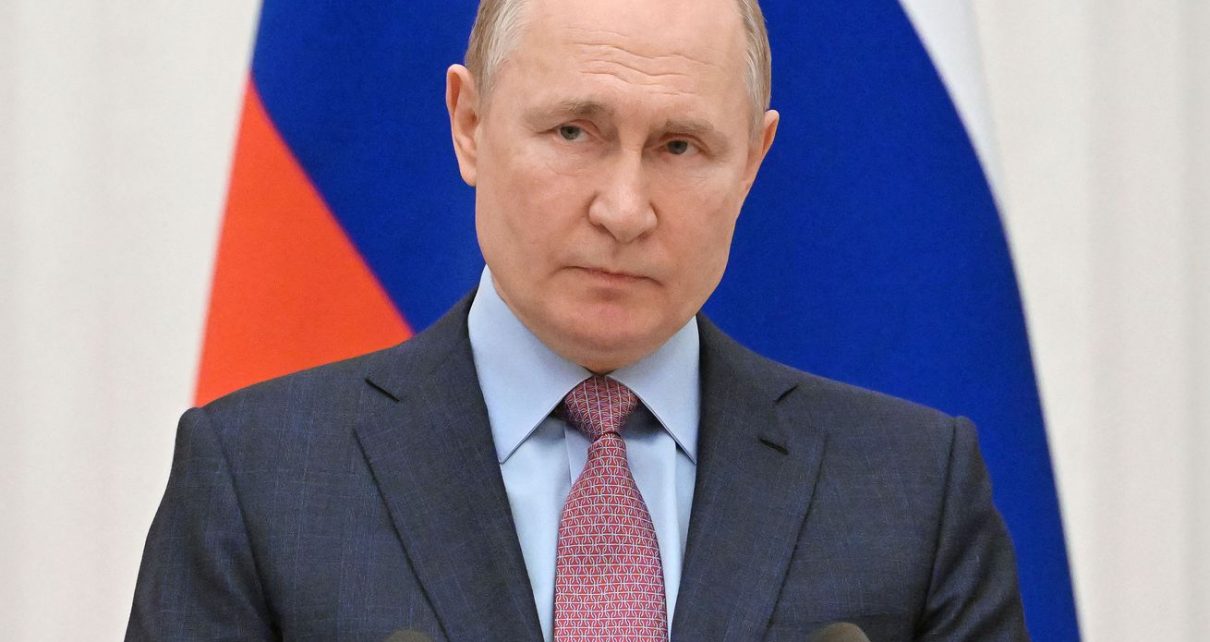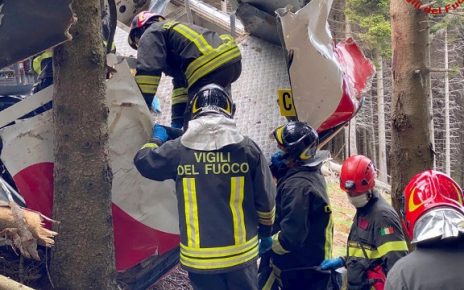
The threat of nuclear weapons never went away. But Putin’s invasion of Ukraine makes it visible again.
When Russian President Vladimir Putin announced his invasion of Ukraine on February 24, he also made a more nebulous threat: “No matter who tries to stand in our way or … create threats for our country and our people, they must know that Russia will respond immediately, and the consequences will be such as you have never seen in your entire history.”
Another part of his speech seemed to make his meaning clear. “Today’s Russia remains one of the most powerful nuclear states,” Putin said. As justification for the invasion, Putin also made unfounded claims that Ukraine was on a path to build its own nuclear arsenal. “There’s no evidence of that at all,” said Hans Kristensen, director of the Nuclear Information Project at the Federation of American Scientists.
On February 27, Putin went a step further, ordering his country’s nuclear forces to a “special regime of combat duty” and blaming “illegal sanctions” and “aggressive statements” from countries in the North Atlantic Treaty Organization (NATO).
Jen Psaki, press secretary for the Biden White House, quickly responded. “At no point has Russia been under threat from NATO,” she said on ABC’s This Week. “We have the ability to defend ourselves.”
The Russian invasion has relied entirely on conventional weapons — tanks rattling down highways, bombers flying overhead, ships landing in the port city of Odesa — and experts told Vox that in the absence of a shocking escalation, that isn’t likely to change.
Still, Putin’s remarks were a stark reminder that nuclear weapons aren’t just the boogeymen of a bygone age, but remain a key part of the security order that emerged after the end of World War II. By Kristensen’s count, Russia has about 6,000 nuclear weapons and the United States has about 5,500. Either nuclear arsenal is large enough to kill billions of people — but also to serve as a deterrent against attack.
In recent decades, the so-called nuclear order has remained fairly stable. The seven other countries known to have nuclear weapons have much smaller arsenals. Most countries in the world have signed onto the Treaty on the Non-Proliferation of Nuclear Weapons (NPT), which limits the development of nuclear weapons. We asked three researchers of nuclear arms control about the risks the world faces now and what we might be able to do about them.
How worried should we be about the threat of nuclear weapons right now?
When Russia first invaded Ukraine, the scholars who spoke to Vox said a nuclear strike is unlikely but still a cause for concern, given that the invasion introduced the largest military operation in Europe since the Second World War.
“I’m more worried than I was a week ago,” Kristensen said. He pointed out that NATO increased its readiness levels for “all contingencies” in response to Putin’s speech, and with increased military buildup comes increased uncertainty. “That’s the fog of war, so to speak,” Kristensen said. “Out of that can come twists and turns that take you down a path that you couldn’t predict a week ago.”
When asked about Putin’s decision to place his nuclear forces on higher alert, Kristensen said, “There is nothing in Russia’s stated public nuclear doctrine that justifies this.” He added, “Putin has now taken yet another step that unnecessarily escalates the situation to what appears to be a direct nuclear threat.”
Matthew Bunn, a professor at the Harvard Kennedy School and former adviser to President Bill Clinton’s Office of Science and Technology Policy, initially told Vox, “I think there is virtually no chance nuclear weapons are going to be used in the Ukraine situation.” The main reason, Bunn said, is that the United States and its NATO allies have made it clear that they will not send troops to Ukraine. Without the threat of military intervention, Putin has little reason to use his nuclear weapons, especially since Russia has a staggering numbers advantage over the Ukrainian military.
Bunn qualified his statements after Putin’s escalation. “No one outside of Putin’s inner circle knows for sure why Putin has taken this action,” he said in an email. “My guess — and it’s only that — is that it is intended as further signaling to deter anyone in the West from even thinking about intervening militarily to help Ukraine.”
Paul Hare, senior lecturer in global studies at Boston University, argued that Putin’s real goal is to “swallow Ukraine” and restore the historical power of imperial Russia. “His objective is not to bring the world to nuclear war,” Hare said.
Hare interpreted Putin’s escalation as a reaction to a wave of international pressure and sanctions. “He feels that this is suggesting Russia is being pushed around by the severe sanctions and unity of Europe,” Hare said in an email. “We do of course hope that Putin is still a rational actor,” he added, by remembering that nuclear war will not serve his aims.
What does Russia’s nuclear arsenal look like? How does it compare to others in the world?
Russia’s roughly 6,000 warheads make it the country with the largest nuclear arsenal. When Russia invaded Ukraine on February 24, Kristensen said most of those warheads were in reserves, with only about 1,600 deployed as land, sea, and air-based weapons, such as missiles in silos or bombs dropped by planes. (When the USSR fell apart at the end of the Cold War, there were nuclear weapons left behind on Ukrainian soil, but Ukraine returned them to Russia.)
The countries known to have nuclear weapons are Russia, the US, China, France, the UK, Pakistan, India, Israel, and North Korea. That includes every permanent member of the United Nations Security Council, which have been working to modernize their nuclear weapons over the past few decades, and three members of NATO. The total number of weapons has dropped by about 80 percent since the end of the Cold War, from an estimated 70,300 in 1986 to 12,700 in early 2022.
That’s still a lot of nukes. “There has been much discussion about whether that means Russia has a sort of trigger-happy nuclear posture,” Kristensen said. “It’s hard to pin down. if Russian officials were asked to sit down around a table and entirely consider how many tactical nuclear weapons were needed, purely based on real, strategic rationales, I suspect that number would quickly drop to a lot less [than what it is today].”
Does Putin have a reason to consider using nuclear weapons?
From a strategic standpoint, the experts said, there’s no reason for Russia to use nuclear weapons. But they said Putin himself was the biggest source of uncertainty. “The element of emotion and anger that’s crept into Putin’s statements in particular is striking,” said Hare. “Normally we’ve associated Russia’s diplomatic style with a kind of laconic, almost sarcastic manner.”
But a nuclear war would undermine any victory Putin might claim in Ukraine, Hare said, likely serving to alienate not just the West but also potential allies such as China. “China will be increasingly alarmed by Putin’s demeanor and will likely be urging him to restore the world order of global trade and investment on which China’s prosperity depends,” he explained. “A nuclear war is China’s worst nightmare.”
It’s worth remembering, Kristensen added, that Putin often makes allusions to Russia’s nuclear arsenal as a show of strength. In 2015, he said in a Russian state TV documentary that he had considered putting Russian nuclear forces on alert during the Russian annexation of Crimea a year prior.
This could be a sign that Putin’s nuclear rhetoric is more bark than bite, but Kristensen wasn’t ready to say that for sure. “He lives in a very small bubble, and he’s deeply paranoid,” Kristensen said. “He’s willing to do really not very rational things.”
Is the fear of a nuclear war enough to stop countries from using nuclear weapons?
“The physical fact of a nuclear weapon’s destructive power absolutely creates fear,” said Bunn. Nuclear deterrence — the idea that one country wouldn’t dare attack another for fear of a nuclear strike — was the major security policy of the Cold War period, and experts say it remains very much alive today. As my colleague Zack Beauchamp recently wrote, the threat of nuclear weapons is the reason the US won’t send troops to Ukraine.
But nuclear deterrence clearly didn’t end all wars. The existence of nuclear weapons “didn’t help us in Vietnam, they didn’t help us in Iraq, they didn’t help us in Afghanistan,” Bunn said. “Nuclear weapons aren’t useful for the majority of the security and well-being challenges that the United States faces.”
Since the Cold War, it’s been widely accepted that nuclear deterrence would help ensure that the borders of Europe would not be challenged. The Ukraine crisis, said Hare, is casting some doubt on that idea. “The credibility of deterrence hasn’t been tested for decades,” Hare said. “The whole international order is sort of being thrown up in the air. Is the Ukraine attack going to be a prelude to an attack on, say, the Baltic states that are even more vulnerable, or is Putin going to be satisfied with Ukraine?”
The answer, Hare said, will shape how the United States and its NATO allies decide to deploy their forces — conventional and nuclear — around the world. “We’re starting to see large powers begin to sort of entertain the thought of limited tactical nuclear weapons use scenarios, in a way that they didn’t spend very much time thinking about 10 years ago,” said Kristensen. These are the sorts of unlikely scenarios that have been tossed around in war games as contingencies since the Cold War, and could entail strikes on isolated military targets that are far from population centers, for example.
“The theory is very much like it was during the Cold War,” Kristensen explained. “You just sort of have some smaller nukes that you can pop off here and there, to force an adversary to take an off-ramp during a conflict.”
Is the world doing a good job keeping nuclear weapons under control?
For the most part, global efforts to prevent nuclear weapons from spreading, like the Non-Proliferation Treaty, have been strikingly successful. But these efforts need constant attention and maintenance. “Globally, the nuclear order is in pretty bad shape,” said Bunn. North Korea continues to build up its nuclear arsenal, India and Pakistan appear to be engaging in an arms race to build up short-range tactical nuclear weapons, and hostility is ratcheting up between the US, Russia, and China.
“People should pay attention,” said Kristensen. “They have to be vigilant about holding their governments accountable, and make sure that the policies that are in place and the way they’re implemented are constructive, that they actually lead to improving the situation rather than making it worse.” A key US-Russia agreement to limit nuclear-armed missiles, known as the New START Treaty, is set to expire in February 2026, and the degraded relations between the United States and Russia will make negotiating a renewal much harder.
“The huge increase in US-Russian hostility will lead to increased risks of conflict and make it more difficult to work with Russia,” Bunn said. “Whether it’s working to prevent the spread of nuclear weapons to other countries or improving security for nuclear weapons and materials and facilities, all of that goes better if the United States and Russia are working together. And they’re not going to be doing that for some time to come.”
There is some good news, Bunn said. There are promising signs for the reinstatement of the Iran nuclear deal, which would affirm the principles of the Non-Proliferation Treaty. “It’s important to remember that only 5 percent of the countries in the world have nuclear weapons,” Bunn said. “Every other state has pledged to never develop nuclear weapons.”
For decades, Bunn added, about one in every 10 US lightbulbs was powered by uranium from decommissioned Russian warheads, which was sent to American nuclear power plants — a reminder that the world actively worked together to turn a tool of destruction into a force for good. “That’s remarkable,” Bunn said. “It’s never been true before in human history that the most powerful weapon available to our species was widely forsworn.”
Update, February 27, 3 pm ET: This story has been updated with additional expert comments following Putin’s order that Russia’s nuclear forces increase their readiness level.





